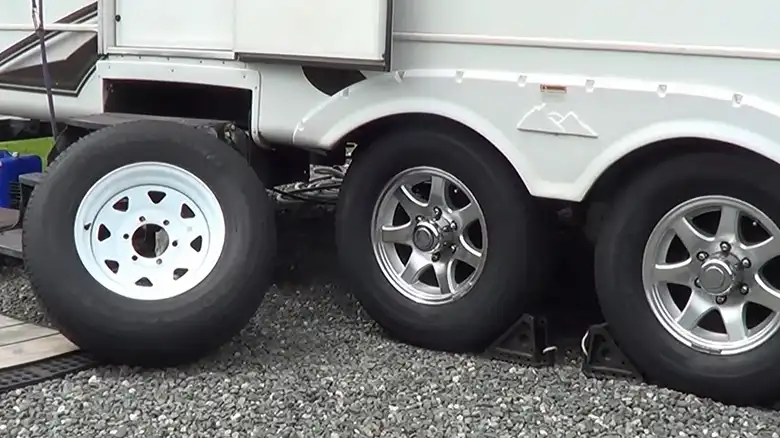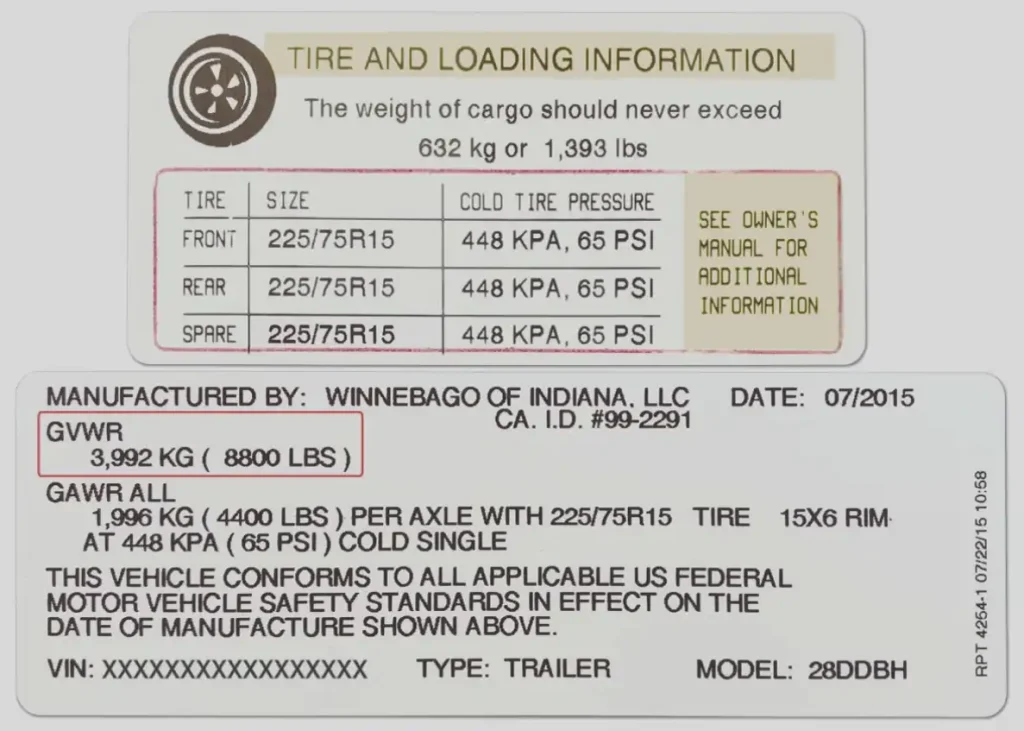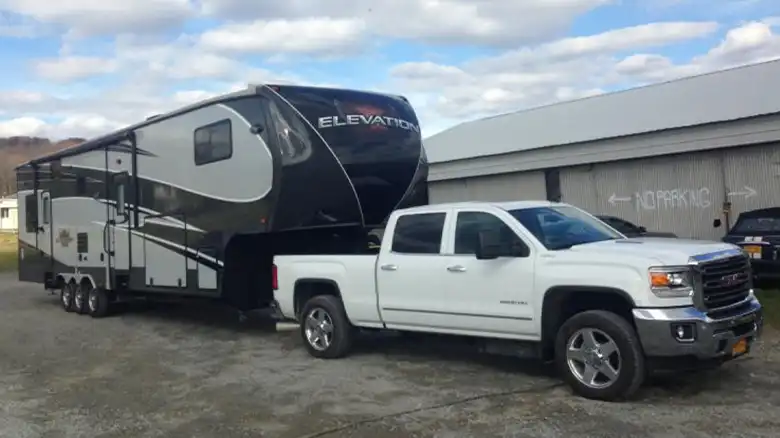When it comes to trailer components, tires tend to be overlooked, taken for granted, or simply misunderstood. Yet these round rubber wonders carry the entire load and enable heading out on adventures near and far. Whether you’re hauling a trusty old flatbed or a state-of-the-art toy hauler, understanding trailer tire basics proves crucial for safety, performance, and avoiding roadside headaches.
Through first-hand experience and many lessons learned the hard way, I’ve become well-acquainted with trailer tires over years of crisscrossing North America. I’ve battled blowouts, decoded unintelligible sidewall markings, and wasted money on the wrong tires a few times. These days, I enjoy paying that hard-won knowledge forward to help fellow towers make informed, confident tire decisions.
That’s why I’m here to unpack critical considerations around trailer tire load capacity, usage cases, maintenance, lifespan, and problem avoidance. I’ll also answer some of the most frequently asked questions about safely putting various types of trailers on the road – from utility and cargo to boat and RV. So, let’s get rolling!

Choosing the Ideal Trailer Tires
The first critical step is choosing new tires specifically engineered to meet your trailer’s needs. Unlike car and truck tires, trailer tires come in a variety of constructions, capacities, and designs. Blindly picking any tire from an auto shop could be disastrous, so let’s cover the key factors to consider:
Understanding Load Capacity & Speed Ratings
Arguably the most important specifications for any trailer tire are its load capacity and speed rating. Load capacity indicates the maximum weight a tire can safely support when properly inflated. The speed rating denotes the sustained speeds a tire can handle without the risk of overheating. Both measures are critical for matching the tire to the gross vehicle weight rating or GVWR of your particular trailer.
Trailer tires have assigned ply ratings from 4-ply to 12-ply to indicate load capacities ranging from 1,820 to 6,614 pounds per tire. Common speed ratings are M, L, and J which equate to 81, 75, and 62 mph maximum speeds, respectively. Always choose a tire with at least a 6-ply rating and L speed rating for general towing unless you have a very lightweight cargo trailer.
To make things easier, here’s a quick tire-size compatibility table –
| Tire Size | Load Range | Load Rating Single | Load Rating Dual |
| 275/70R22.5 | H 16-ply rated | 6610 @ 125 PSI | 6175 @ 125 PSI |
| 12.00 x 16.5 BIAS | F 12-ply rated | 4045 @ 75 PSI | 3560 @ 75 PSI |
| 245/70R17.5 RADIAL | H 16-ply rated | 6005 @ 125 PSI | 5675 @ 125 PSI |
| 235/75R17.5 RADIAL | J 18-ply rated | 6005 @ 127 PSI | 5675 @ 127 PSI |
| 235/75R17.5 RADIAL | H 16-ply rated | 6005 @ 125 PSI | 5675 @ 125 PSI |
| 295/70R22.5 | H 16-ply rated | 6610 @ 120 PSI | 6005 @ 105 PSI |
| 215/75R17.5 RADIAL | H 16-ply rated | 4805 @ 123 PSI | 4540 @ 123 PSI |
| 255/70R22.5 | H 16-ply rated | 5510 @ 115 PSI | 5070 @ 115 PSI |
| ST 235/80R16 RADIAL | E 10-ply rated | 3520 @ 80 PSI | 3080 @ 80 PSI |
| ST 225/75R15 RADIAL | D 8-ply rated | 2540 @ 65 PSI | 2200 @ 65 PSI |
| LT 235/85R16 RADIAL | G 14-ply rated | 3750 @ 110 PSI | 3200 @ 110 PSI |
| 11R22.5 | G 14-ply rated | 6610 @ 120 PSI | 6005 @ 120 PSI |
| ST 205/75R15 RADIAL | C 6-ply rated | 1820 @ 50 PSI | 1610 @ 50 PSI |
| ST 225/75R15 RADIAL | C 6-ply rated | 2150 @ 65 PSI | 1875 @ 65 PSI |
Exceeding either the load or speed limits risks damage from excessive heat and sudden air loss. At best, this causes quick wear and tear. At worst, it can lead to a dangerous blowout. Refer to your trailer manual or VIN sticker for the GVWR and choose tires at or above that specification.
Bias-Ply vs. Radial Tires: What’s Best for Your Trailer?
The internal construction and materials used in a tire impact its durability, ride quality, and cost. Most modern trailer tires use a radial construction with sidewalls reinforced by steel belts. Radials run cooler, flex better, and provide a smoother ride compared to older bias-ply models. However, bias-ply tires still excel at handling heavy loads thanks to their sturdy crisscross inner linings.
If your trailer hauls heavyweight gear like livestock, equipment, or boats, the extra durability of bias-ply tires makes them a smart choice. For lighter campers and utility trailers, radials strike a better balance of strength, handling, and value. Either tire can work for general towing as long as its load ratings match the trailer’s specs.
Specialty and Seasonal Trailer Tires for Better Performance
Don’t forget that certain trailers like horse and boat trailers have specialty tires to provide extra traction. The type of terrain you’ll be covering is also essential. If towing through snow, mud, or loose gravel is unavoidable, consider all-season or aggressive mud terrain tires. Just confirm any specialty tire you choose has an equivalent or higher weight and speed rating compared to the stock tires.
Temperature is another seasonal factor for tire compounds. In summer heat, target tires with resistance to cracking and deterioration from UV rays and ozone exposure. Come winter, choose compounds designed to remain flexible and grippy at colder temperatures and on icy roads. Keeping a separate set of summer and winter tires can maximize safety and extend usable life.
Key Considerations When Buying Trailer Tires
Along with verifying essential ratings and design factors, evaluating options on treadwear warranties, brand reputation, and pricing is wise. Tires carrying longer tread life expectancies suggest durable compounds and quality construction. Mixing established brands with cheaper no-names can cause uneven wear. And purchasing all four tires simultaneously promotes balanced wear across axles.
Trailer Tire Maintenance: Tips for Longevity and Safety
Installing the proper new tires is merely step one. Keeping tires properly maintained via regular inflation checks, timely rotation, and visual inspections are equally vital for optimized handling, safety, and operational life. Let’s explore the best practices any trailer owner can follow.
The Importance of Proper Tire Inflation for Trailer Safety
Ensuring tires remain inflated to the pressure recommended by the manufacturer is paramount. Underinflation strains tires generates excessive heat, reduces fuel economy, and can lead to catastrophic blowouts. Overinflation causes uneven treadwear, compromises handling, and produces an overly stiff ride.
Use a quality pressure gauge to check inflation at least monthly and before any extended hauls. Most tires specify maximum pressure amounts molded into the sidewall. Adjust in small increments of 2-3 PSI until reaching the target number. Recognize that warmer outdoor temperatures may require slightly higher pressures than cool garage readings.
Advanced tire pressure monitoring systems are also available to measure inflation levels while towing. The sensors transmit wireless alerts whenever they cross safety thresholds. This technology enhances blowout prevention and takes the guesswork out of pressure checks.
Tire Rotation, Balancing, and Regular Inspections
Rotating trailer tires every 6,000-8,000 miles promote even treadwear by alternating their orientation and position. This helps them last longer before requiring replacement. Tires should rotate front-to-back in either a crisscross or straight-back pattern depending on axle configuration.
Balancing is another integral service whenever rotating tires or after any repair work. Technicians add measured weights to counteract inherent unevenness in the tire and wheel assembly. Proper balancing keeps the trailer chassis stable, reduces vibrations, and prevents spotty treadwear from imbalance.
Common Trailer Tire Problems and How to Avoid Them
In addition to pressure and balance, visually inspecting tires before each trip provides valuable information on their health. Use the penny test to check if tread depths fall below 2/32”. Identify any bubbled sidewalls, cracks, cuts, or exposed belt wires requiring immediate repair or replacement. Also, look for abnormal heel-toe wear indicating alignment issues.
If damage looks minor, add the tire to a watch list for accelerated deterioration. For more severe cases likely to cause air loss, remove and replace the tire before hauling. Checking age and condition annually even for spare tires prevents nasty surprises should you need it roadside.
Avoiding Common Trailer Tire Problems
Taking preventative measures by choosing quality tires, maintaining them routinely, and inspecting them often works wonders for avoiding headaches. However, even responsible owners sometimes encounter problems like blowouts, overload damage, or environmental wear. Recognizing the common causes and minimization tactics for such issues is invaluable knowledge.
Preventing Dangerous Blowouts
Blowouts stand as the most disruptive and potentially dangerous trailer tire failures. The air rapidly escaping a ruptured sidewall or shredded tread can throw a trailer into uncontrollable fishtailing. Blown tires also leave you stranded awaiting repair or replacement.
While sudden air loss triggers blowouts, the root causes often involve poor maintenance like underinflation, overloading, or excessive speed. Heat and friction from straining a tire exponentially accelerate internal deterioration until failure occurs. Thankfully, inspecting tires regularly and adhering to usage to their rating limits blowout chances.
If a blowout occurs unexpectedly, gradually reduce speed while maintaining control until you can safely pull over. Blowouts on tandem axle trailers may allow limping a short distance to park safely. However, stop immediately if handling feels compromised. Always carry adequate roadside equipment like a spare tire, jack, and wheel chocks.
Overload Dangers
Exceeding a trailer’s GVWR or the individual tire load ratings almost invariably leads to trouble. The stakes also heighten when towers mismatch tires of different ratings across the trailer axles. Even hundred-pound overages on a few tires hugely magnify internal heat and strain.
Be religious about confirming that load weights stay in the specification for the overall trailer and wheel position. Overloading severely accelerates wear, impairs handling stability, and causes excessive tire squirming that intensifies blowout risks. These consequences just don’t warrant pushing limits.
Sun and Ozone Damage
Prolonged sun exposure and ozone off-gassing slowly deteriorate rubber composites through a process called weathering. Over months or years, UV radiation and pollution degrade tire sidewalls, causing cracking and brittleness. These microscopic fissures enable air seepage or blowout-inducing flex failures.
When storing trailers long-term, avoid leaving tires sitting statically in direct sunlight whenever possible. Park under roofs, covers, or breathable tire bags. If storing outdoors is unavoidable, relocate the trailer periodically so tires wear evenly rather than develop flat spots. These measures minimize weathering and extend usable life.
For trailers used daily or on lengthy road trips, quality tire covers defend against sun damage while towing. They also deter grime buildup that necessitates frequent cleaning. Covers made specifically for trailer tires secure tightly and withstand highway speeds. Just take care when installing them to avoid scuffing the tires.
Additional Trailer Tire Resources
Gaining confidence in handling your tire maintenance or knowing when to seek professional assistance instead, requires continual learning. Here are some additional handy resources I recommend trailer owners utilize.
TireRack.com maintains an extensive database of trailer tire brands, models, sizes, ratings, and specifications. Their comparison tools help match tires to your usage needs. Retailers across the country also install TireRack’s tires if they prefer local shops over drop shipping.
Goodyear RV Tires publishes an excellent general reference on understanding tire markings, reading sidewalls, inspection tips, and regularly updated FAQs. Their articles help demystify trailer tire specs and maintenance best practices.
For hands-on learning, I also recommend YouTube channels and videos demonstrating proper inflation, patching methods, wheel torque, and tire replacement on various trailer setups. Visuals always help techniques click faster.
Regulations and Environmental Considerations
Along with leveraging educational resources to make informed tire decisions, responsible trailer owners should familiarize themselves with regulations concerning registration, towing policies, and proper disposal. Regulations vary regionally, so check state DOT websites for specifics.

Used tires end up in landfills far too often, leaching contaminants over time. Instead, reuse, recycle, or search for retailers accepting tires for environmentally-friendly disposal. Tires requiring replacement due to age rather than tread wear make great spares or trailer parking brake anchors too. Keeping even a few tires out of landfills each year benefits everyone long-term.
Maintain Safety Through Ongoing Tire Education
The foundation for safe, dependable trailering lies in understanding and maintaining your tires properly. Yet with varied usage needs, evolving technologies, and wear over years of service, continuing education on trailer tires proves vital. I hope this guide provided a robust starting point for choosing, caring for, and avoiding pitfalls with your trailer’s tires. Please reference it whenever questions or situations arise. Here’s to many safe, successful journeys ahead!
How often should I rotate my trailer tires? For most trailers, tire rotation helps promote even wear and is recommended every 6,000-8,000 miles or about once a year for average users. The most common rotation pattern is moving the front tires straight back and the rear tires forward in a crisscross. Always check your manual as some specialty trailers have different guidelines.
Related FAQs
How Long Do Trailer Tires Last?
With proper maintenance like routine pressure checks, rotation, and avoiding overloads, quality trailer tires can last 4-6 years or more. Tires aged over 10 years old should be inspected annually regardless of tread depth and replaced by 12 years old.
What is the Load Range on a Trailer Tire?
Load range refers to the maximum weight a tire can support at a certain pressure. Typical ranges are D, E, G, H, L, and N corresponding to increasingly heavier capacities. Always match the load range to trailer weight ratings.
How Can You Protect Trailer Tires from Dry Rot?
Avoid leaving tires sitting fully exposed to sunlight, which degrades rubber over time, leading to dry rot cracks. Store indoors or under covers when possible. If outdoor storage is unavoidable, use tire bags and relocate the trailer periodically to shift weight and exposure.
Can I Use Trailer Tires on My Car/Truck (Or Vice Versa)?
It’s not advisable due to differing tire construction and safety considerations between vehicles. Trailer tires are made to roll straight rather than handle cornering. Vehicle tires must withstand lateral mobility stresses that trailer tires are not designed for.
Why Are Trailer Tires, Bias Ply?
The crisscrossed casing design of bias ply trailer tires makes them extremely durable for heavy loads compared to radials. Many boat, horse, and heavy equipment trailers rely on the sturdy construction despite a stiffer ride. Still, radials work well for lighter general trailering.


